Pamukkale, meaning "cotton castle" in Turkish, is one of the most iconic natural sites in the country. Formed by millennia of geological activity and rich mineral deposits, the site is best known for its snow-white travertine terraces cascading down the hillside like frozen waterfalls.
We visited Pamukkale as part of this guided day tour from Antalya that also included time at the ancient city of Hierapolis. The tour gave us ample free time to explore Pamukkale at our own pace—barefoot and camera in hand. Much of our afternoon was spent walking barefoot along the travertines, dipping our feet into warm mineral pools, and pausing to admire the subtle gradients of white, blue, and mineral-rich gold that define the landscape.
While it is undeniably a tourist hotspot, we found it entirely deserving of the hype.
Cotton castle
Pamukkale is known for its dazzling white terraces, formed over millennia by calcium carbonate deposits left behind by mineral-rich spring waters that flow from a nearby fault line. Over time, these deposits hardened into travertine, creating a stepped series of pools, walls, and ridges that glisten in the sun and feel otherworldly beneath bare feet.
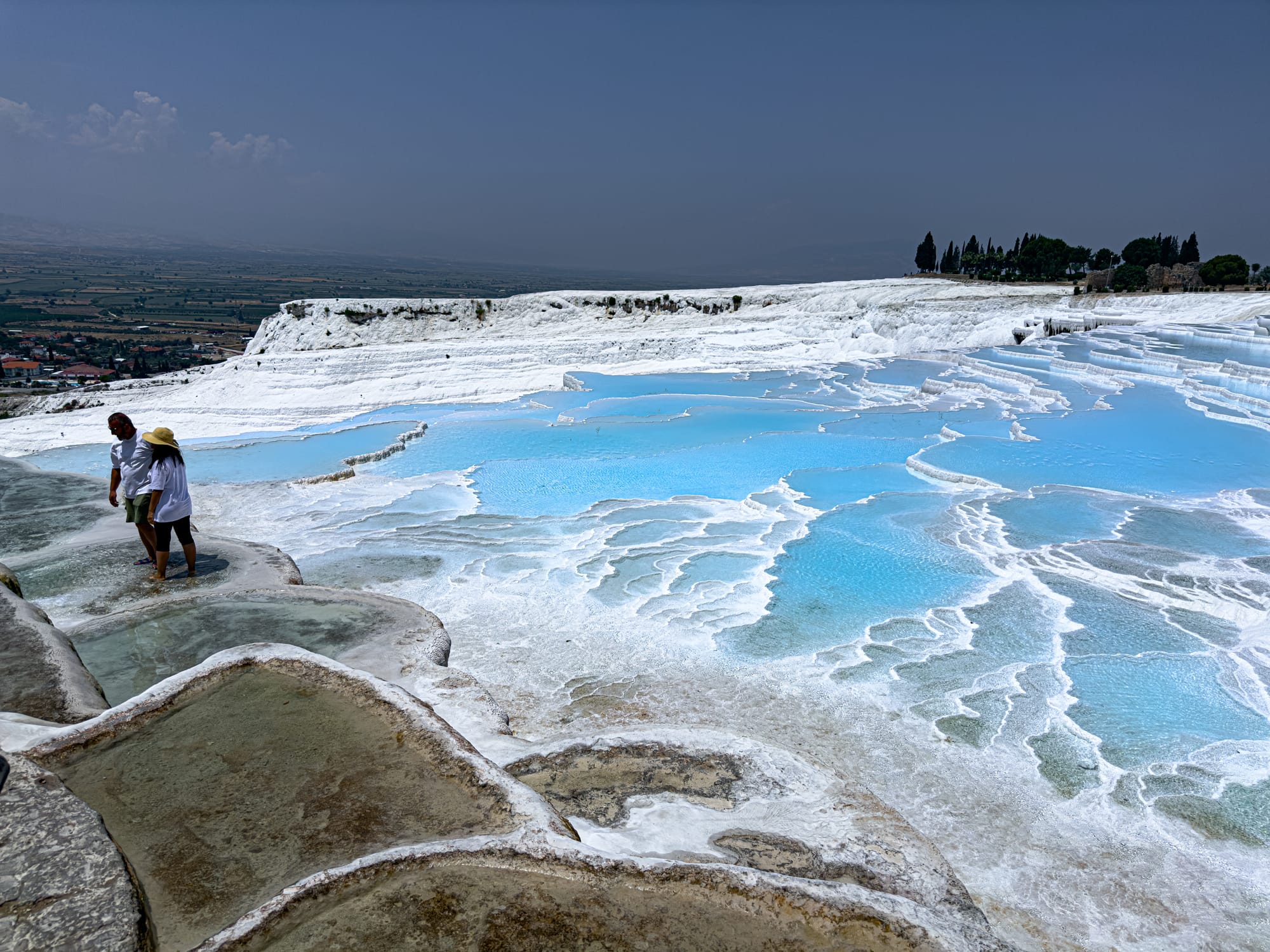
The formations are created by a continuous flow of geothermal water, which emerges from the earth at around 35°C (95°F) and cascades down the hillside. As the water cools, it releases carbon dioxide and deposits calcium carbonate, slowly building up the snow-white formations Pamukkale is famous for.
The history of Pamukkale and its sacred waters
Pamukkale wasn’t just a natural wonder—it was a sacred site. Since antiquity, the thermal waters were believed to have healing properties, drawing travelers, aristocrats, and patients seeking relief from ailments of the skin, joints, and spirit.
The nearby city of Hierapolis, established by the Seleucids and later embraced by the Romans, grew up around these springs. The ancient inhabitants constructed baths, temples, and even a grand necropolis to serve the pilgrims who came to the site for curative purposes. The city became a flourishing spiritual and cultural center, and the thermal waters were central to its identity.
Romans and Byzantines alike bathed here, and the remnants of these ancient spas and communal pools can still be found. It’s even believed that Cleopatra herself may have bathed in the waters, lending yet another layer of myth and allure.
Walking on the travertines
One of the most memorable parts of visiting Pamukkale is walking barefoot along the travertine terraces. Shoes aren’t allowed on the white calcium surfaces, both to preserve the delicate formations and to allow for a more intimate experience. The feeling underfoot shifts constantly—from warm and soft to textured and gritty, depending on how recently water has flowed over that particular section.
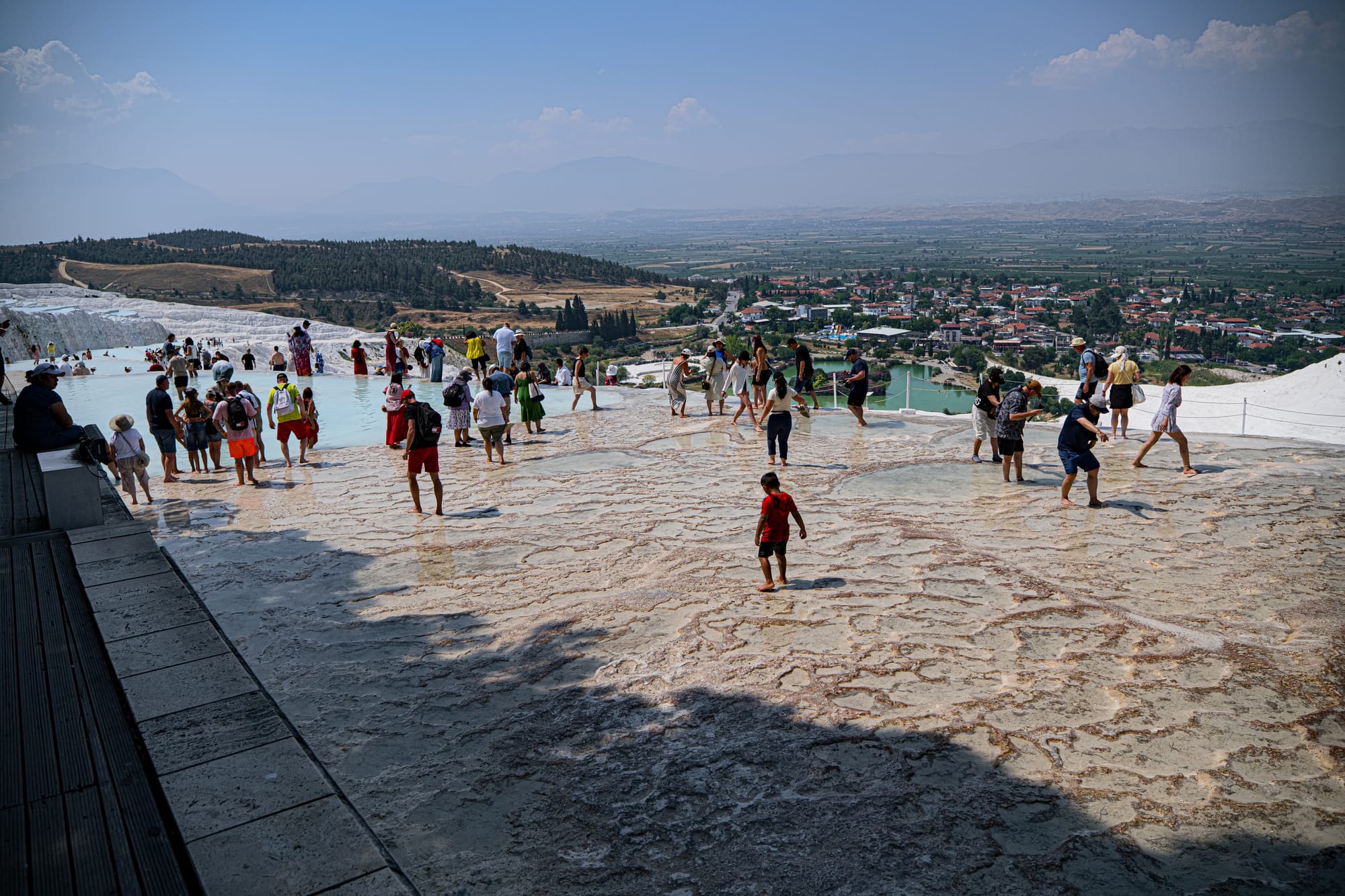
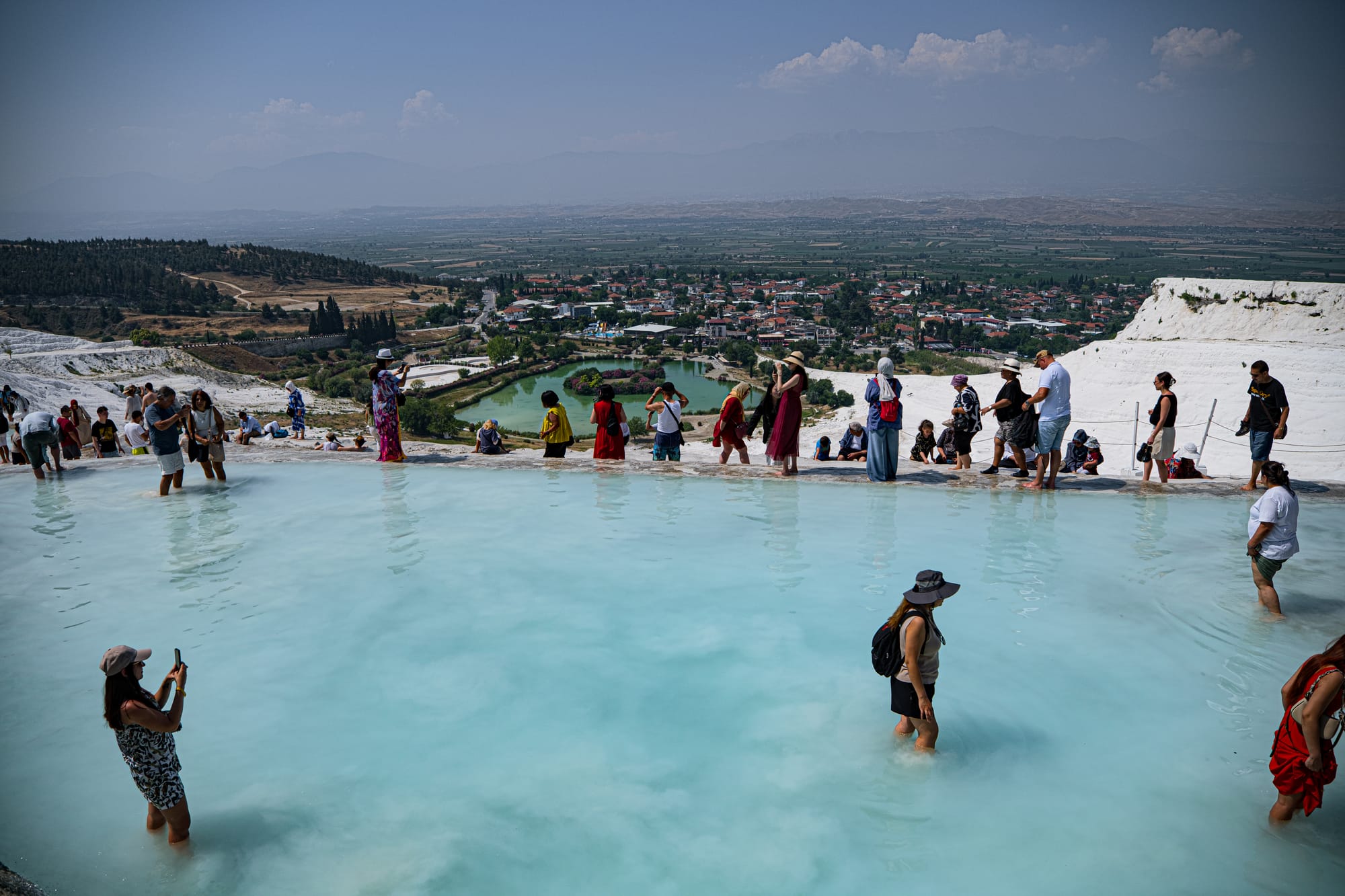
Crowds gather to wade through Pamukkale’s warm turquoise pools, perched above panoramic valley views
As you make your way across the slope, you’ll pass shallow pools of mineral water reflecting the sky, small waterfalls spilling over ridges, and textured basins that look like sculpted moonscapes. The water can range from comfortably warm to refreshingly cool, and the play of light on its surface is endlessly captivating.
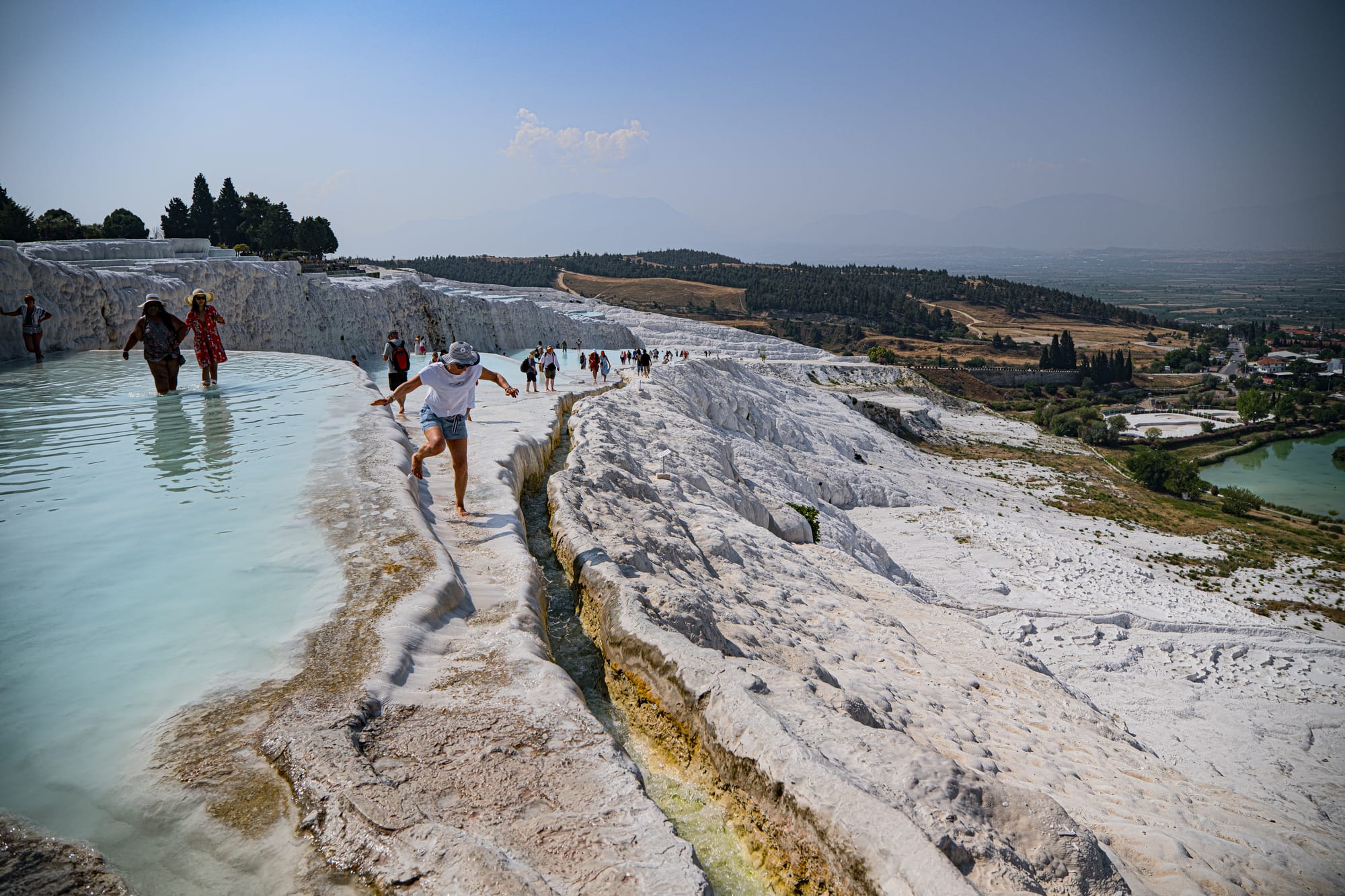
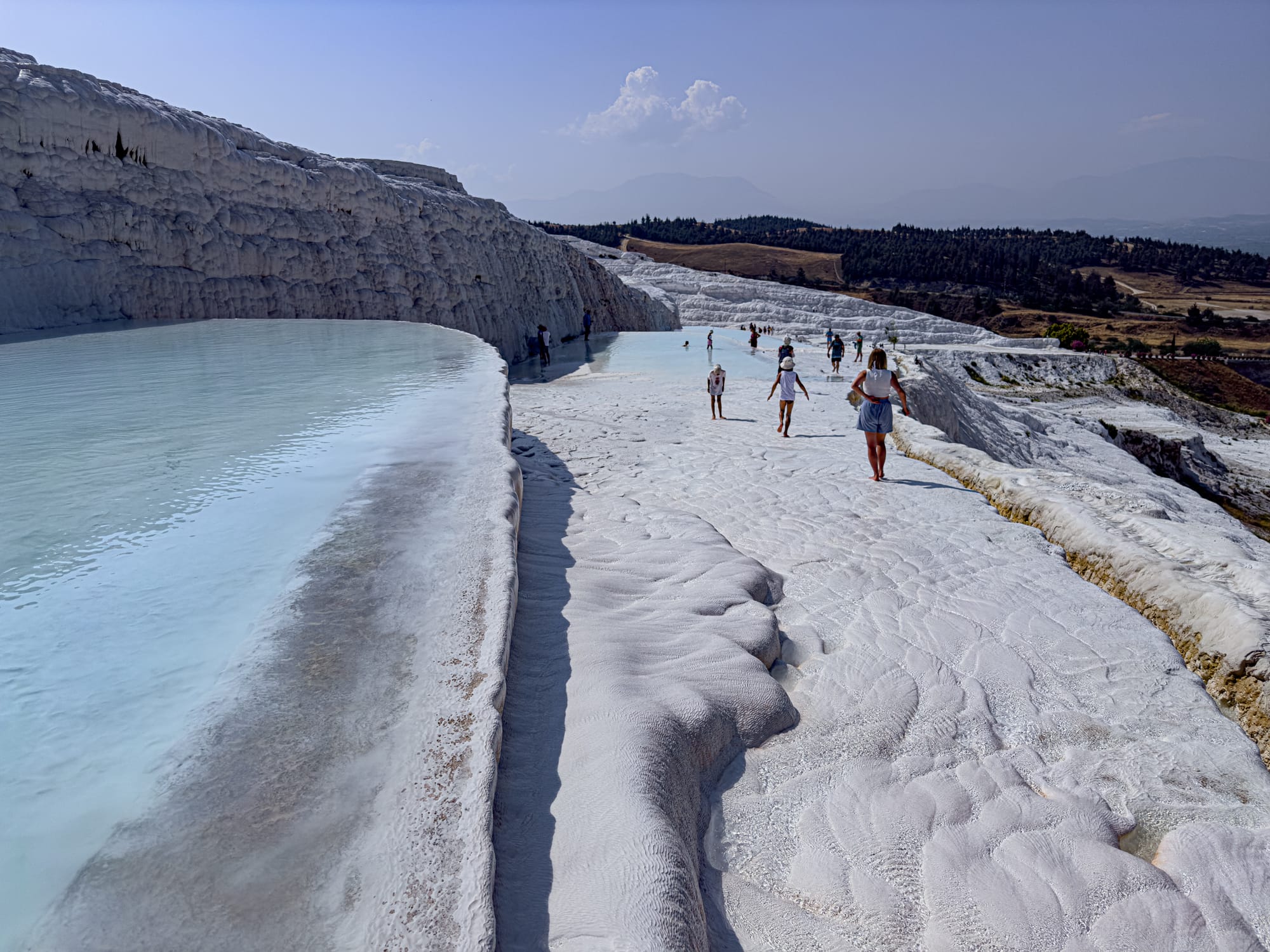
Walking barefoot across Pamukkale’s warm travertine ledges—a surreal blend of geology and motion
Some areas are dry and crackling underfoot, while others are slippery and silken, coated in a fine mineral sheen. Take it slow, pause often, and look down—the patterns are as beautiful as the views.
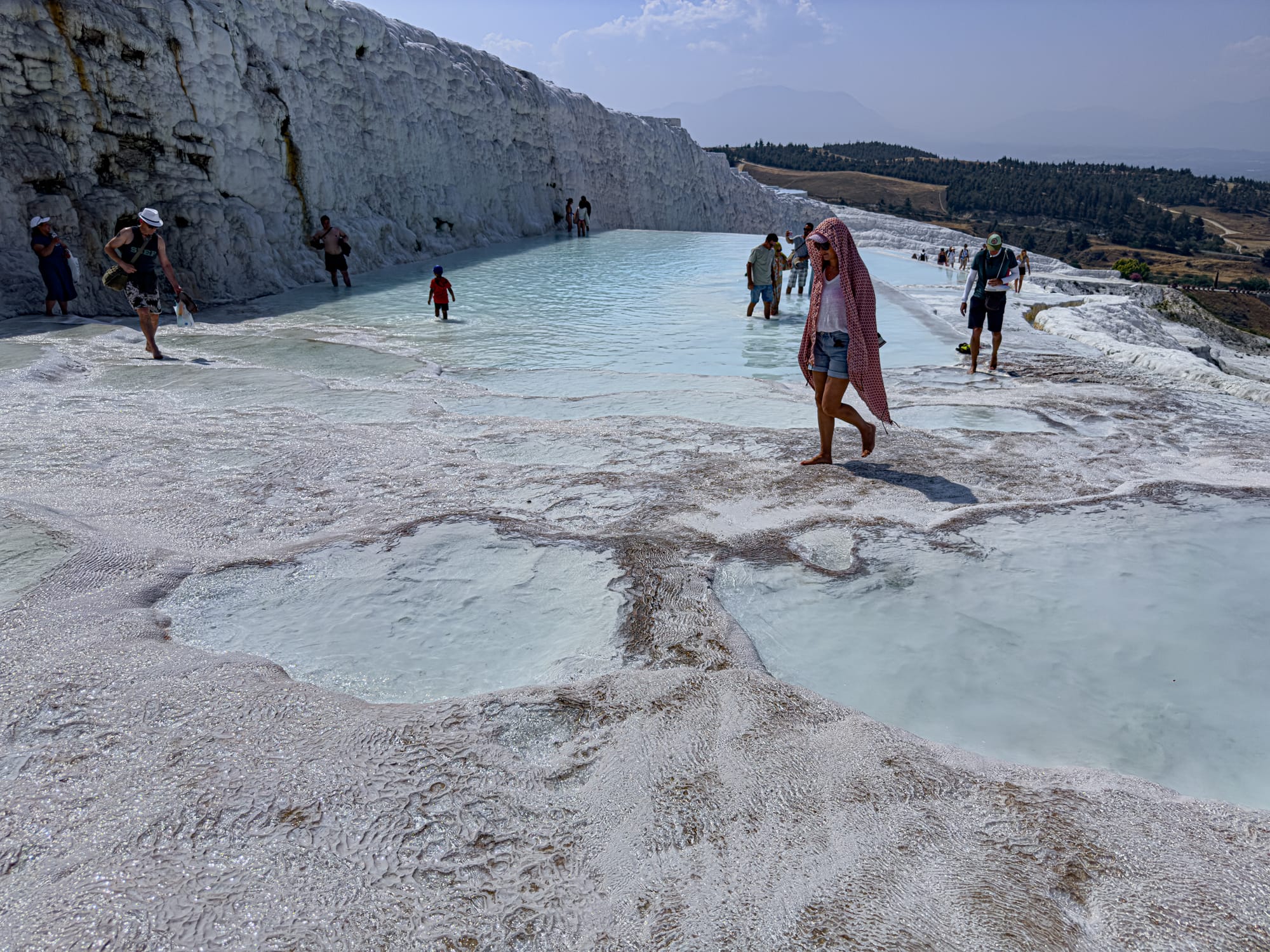
We found that some of the most photogenic and peaceful areas were a little further down the slope, away from the larger pools near the entrance.
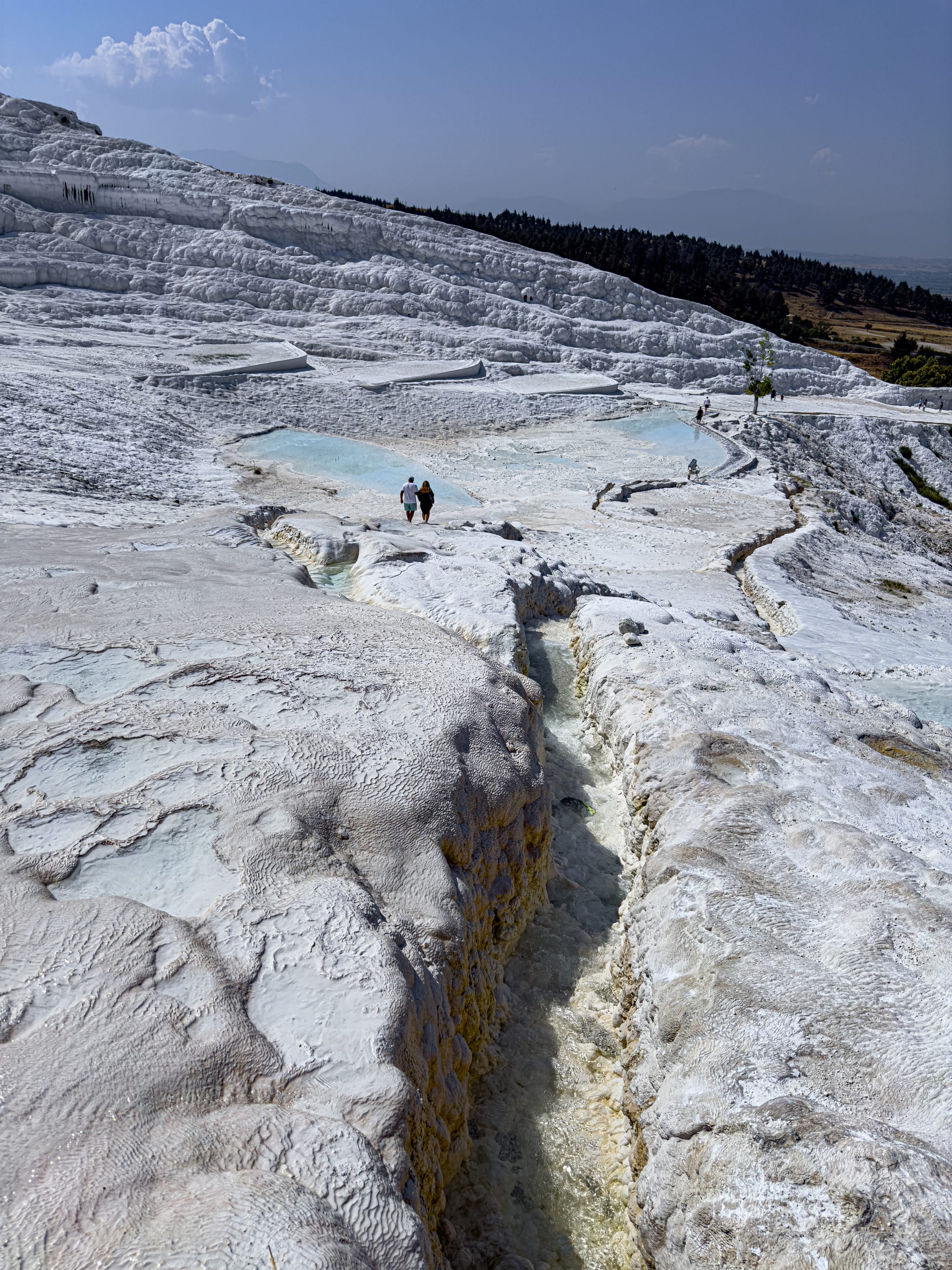
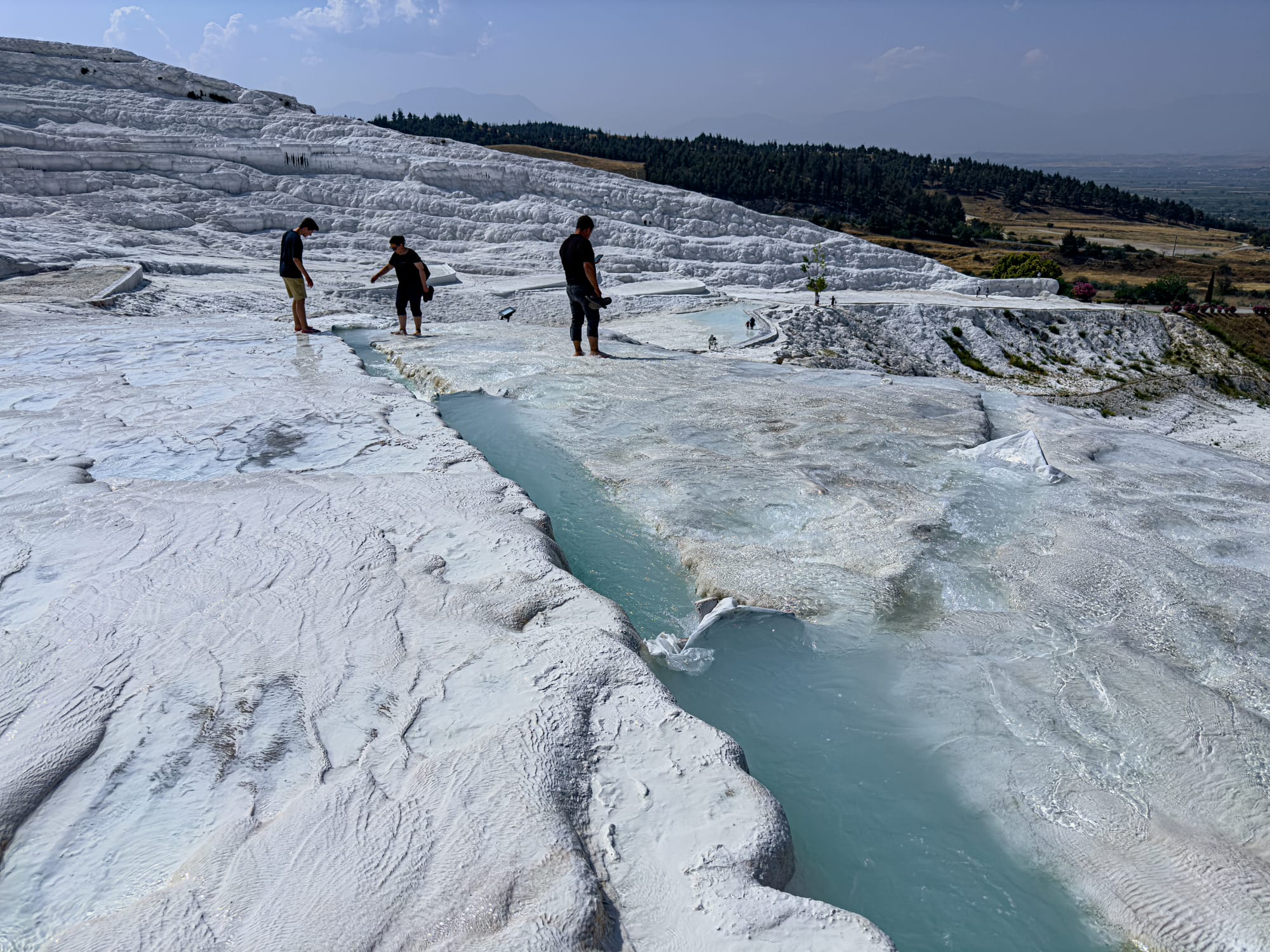
Winding rivulets of turquoise water carve their way through Pamukkale’s surreal calcium-white surface
If you’re able, take your time exploring different levels.
The textures of Pamukkale
Up close, Pamukkale is just as beautiful as it is from afar. The terraces are etched with intricate, almost cellular patterns—repeating scales, ridges, and ripples that change depending on where you are. Some are chalky and dry, others glisten under thin sheets of water.
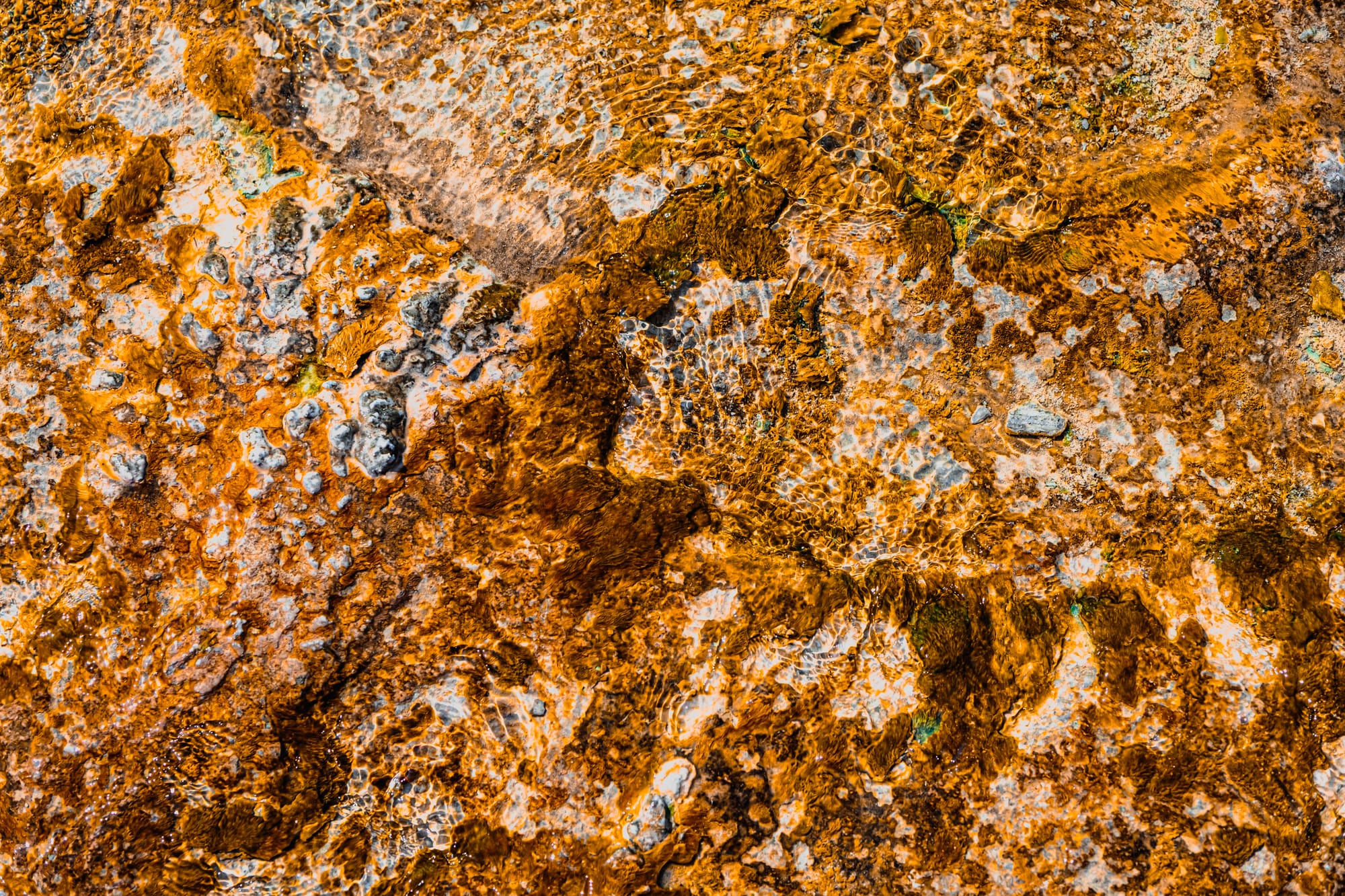
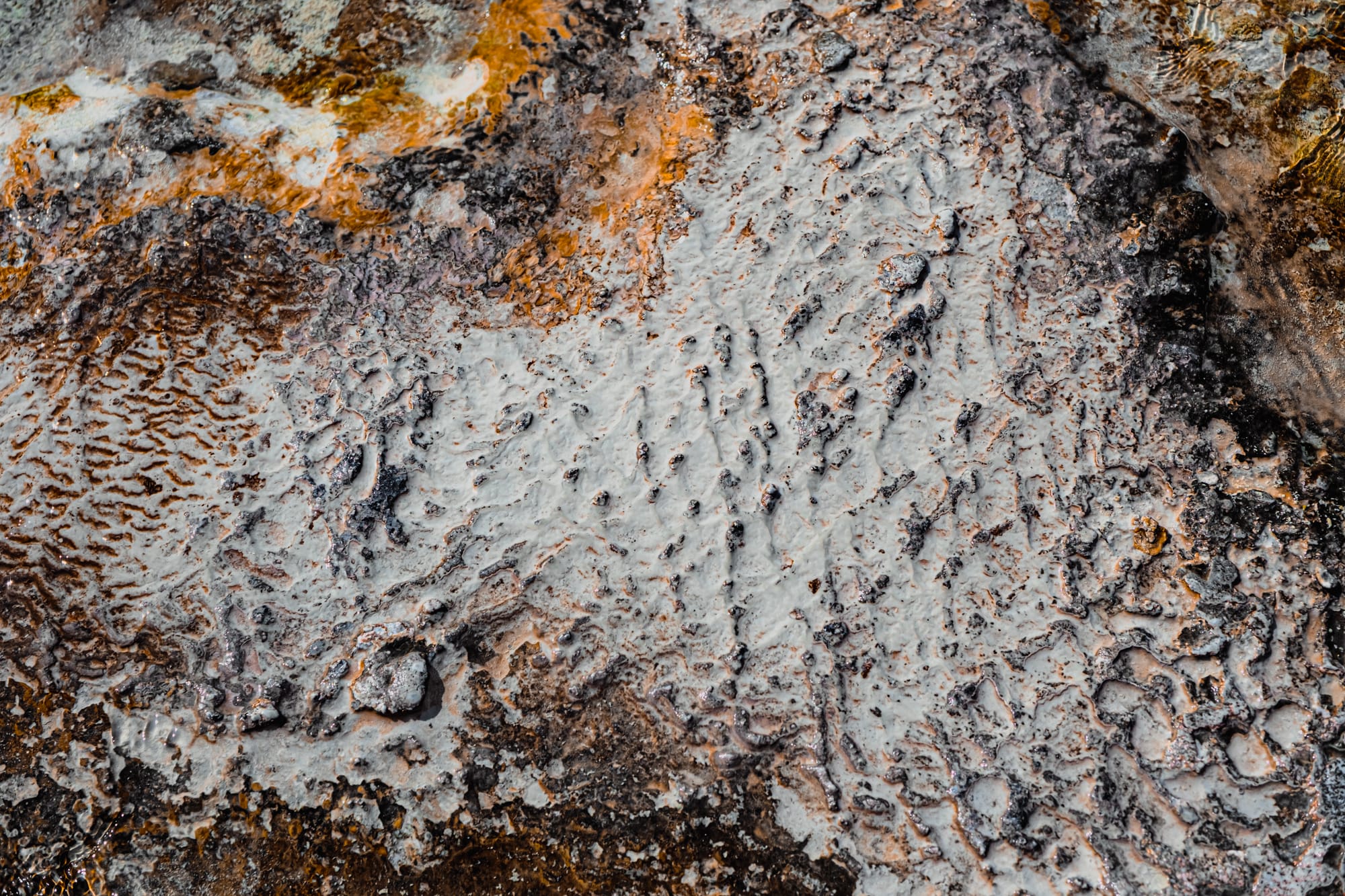
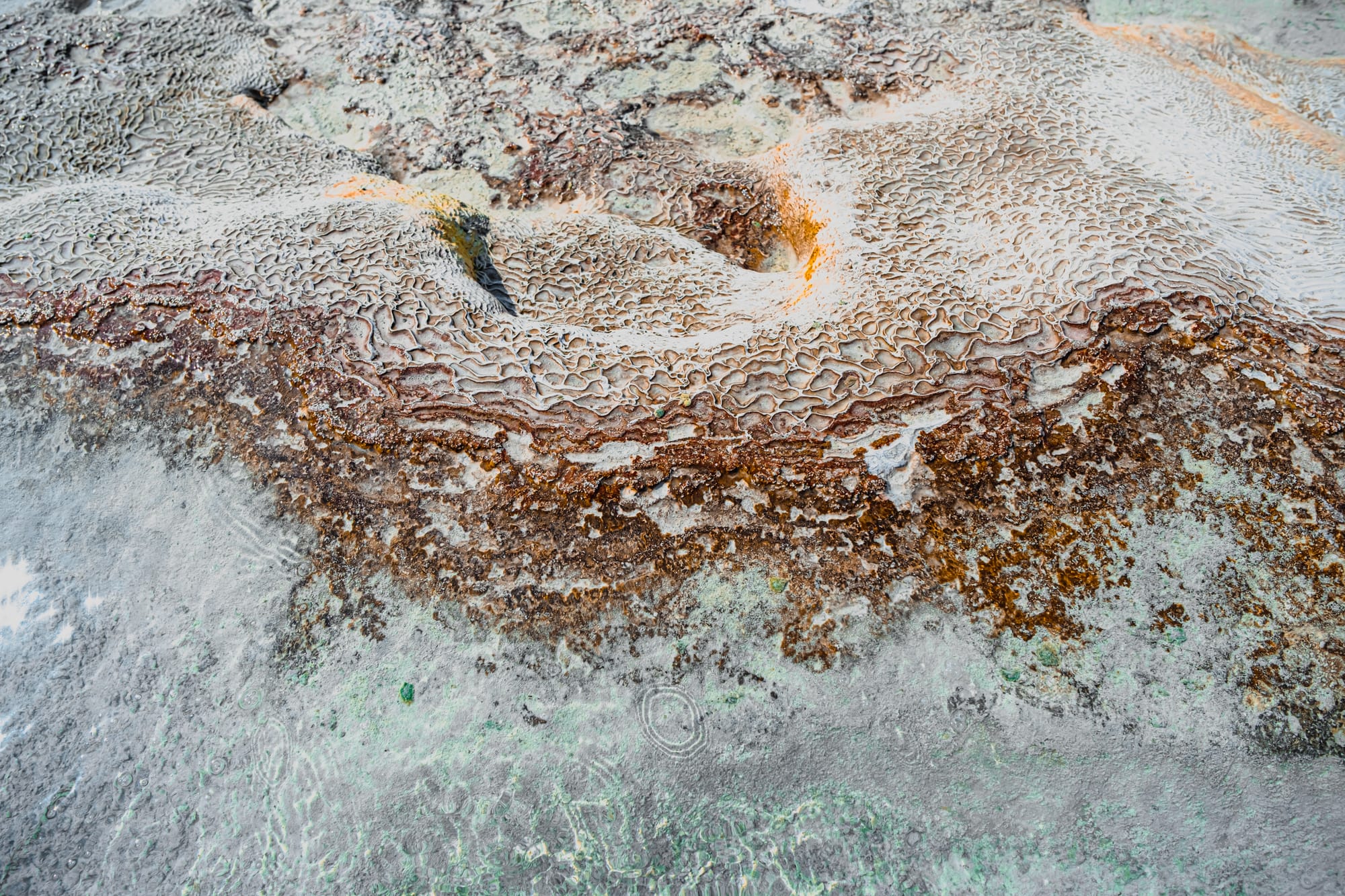
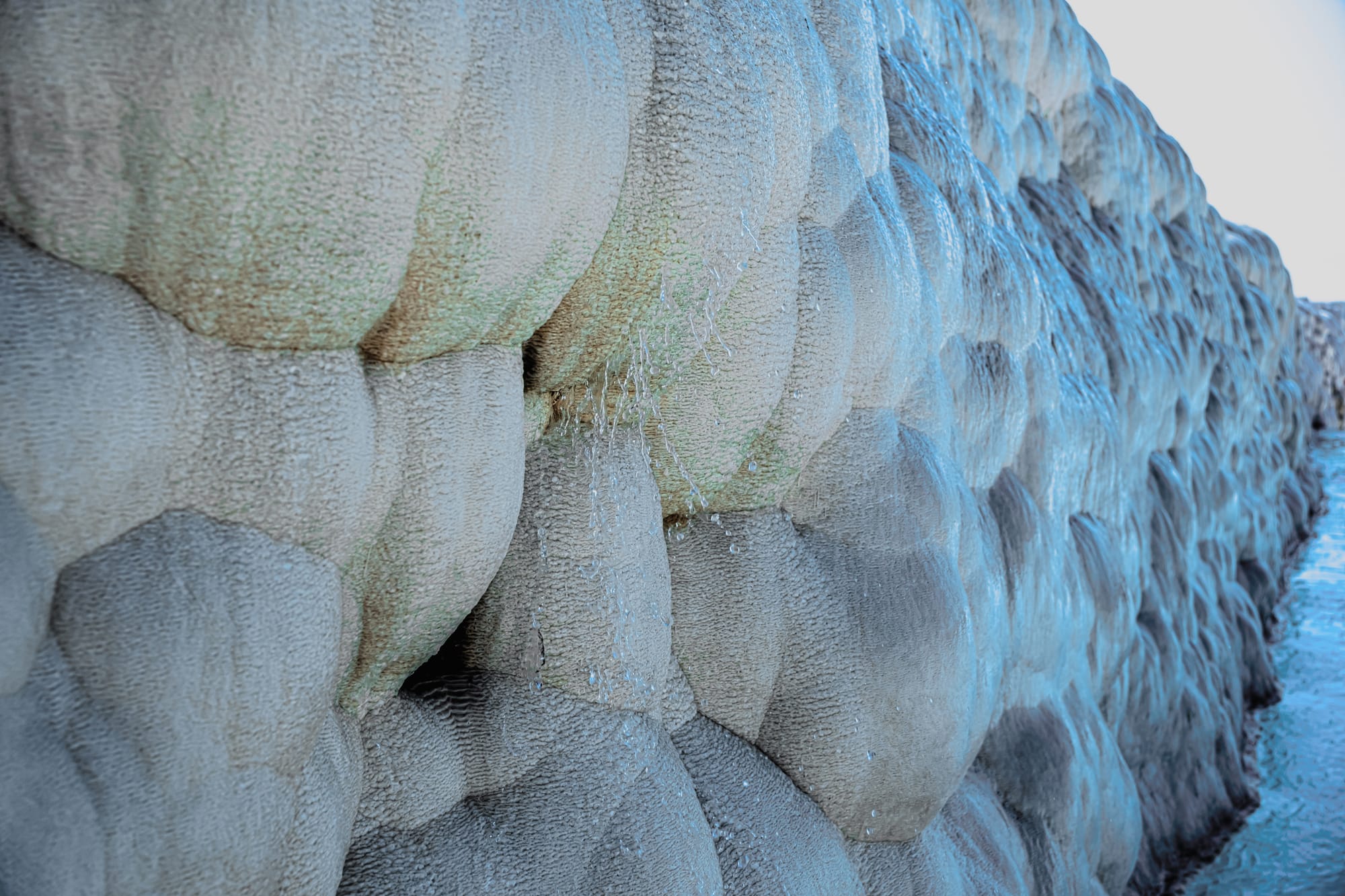
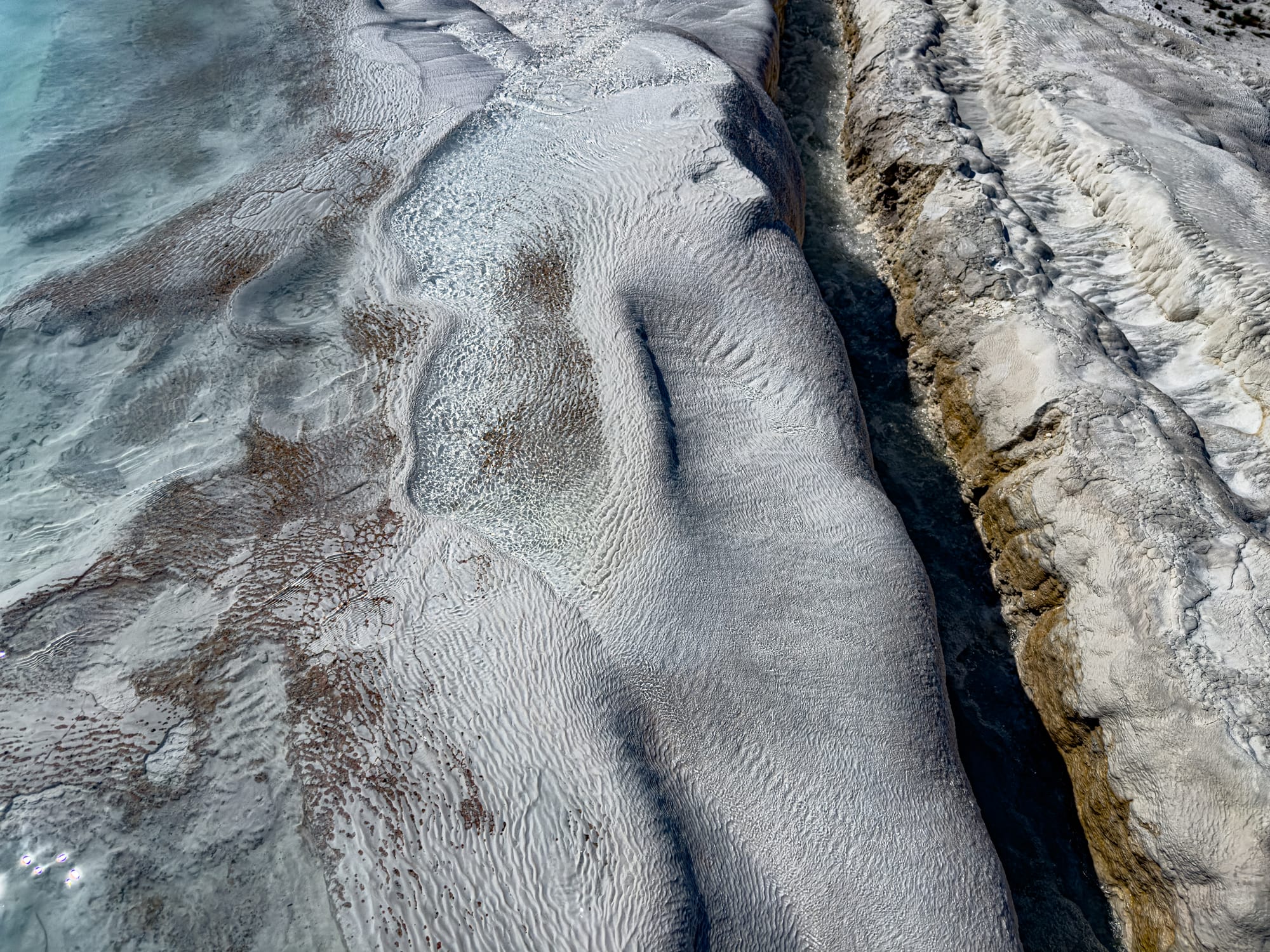
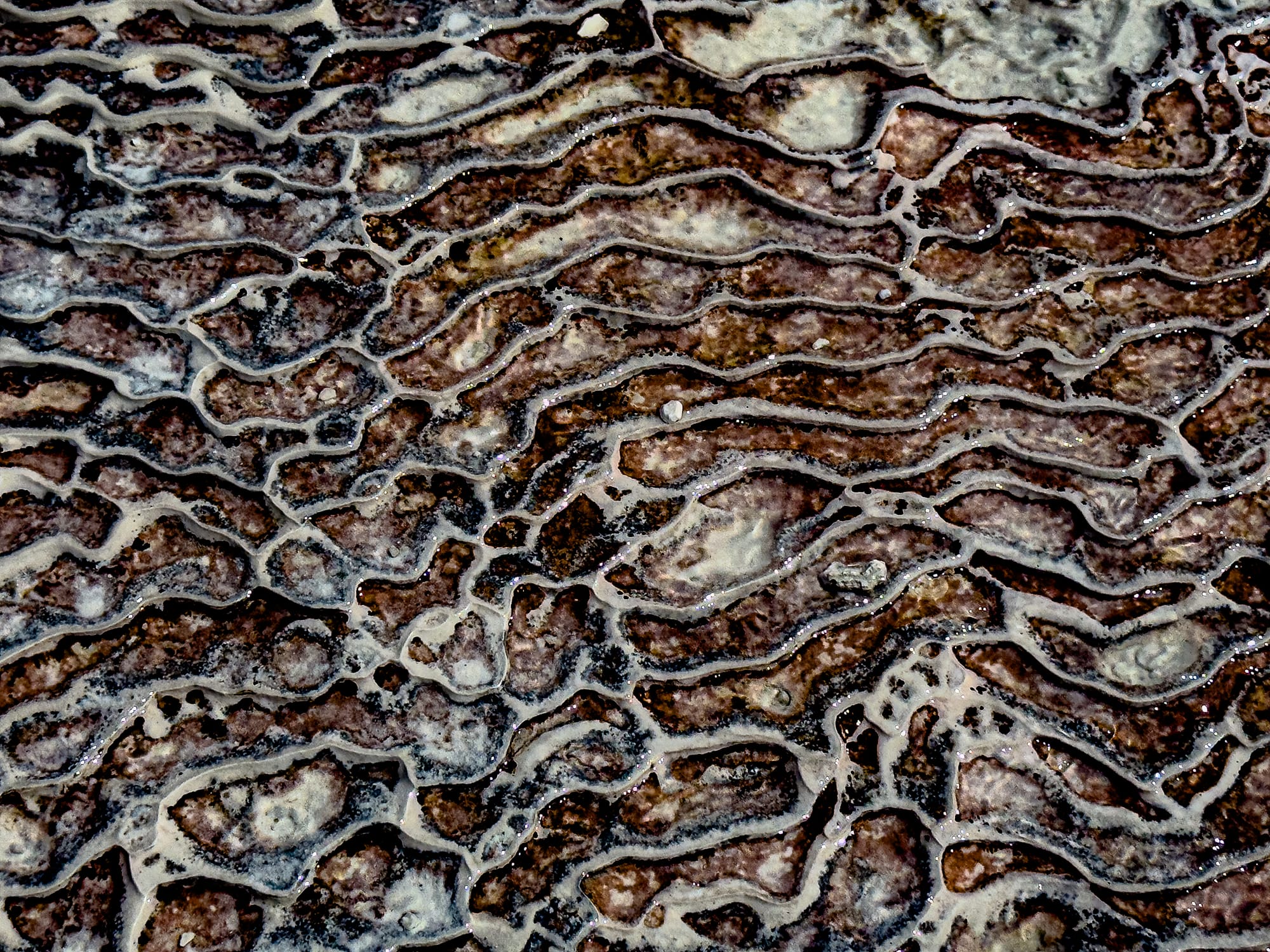
Close-up textures of Pamukkale’s travertines reveal layered ripples, bulbous formations, and mineral-streaked surfaces
In our wanderings, we came across areas stained with soft golds and rust tones, others coated in snowy white, and even places where algae and minerals created greenish-brown abstract swirls. The surfaces sometimes resemble coral reefs, fossilized waves, or lacework in stone.
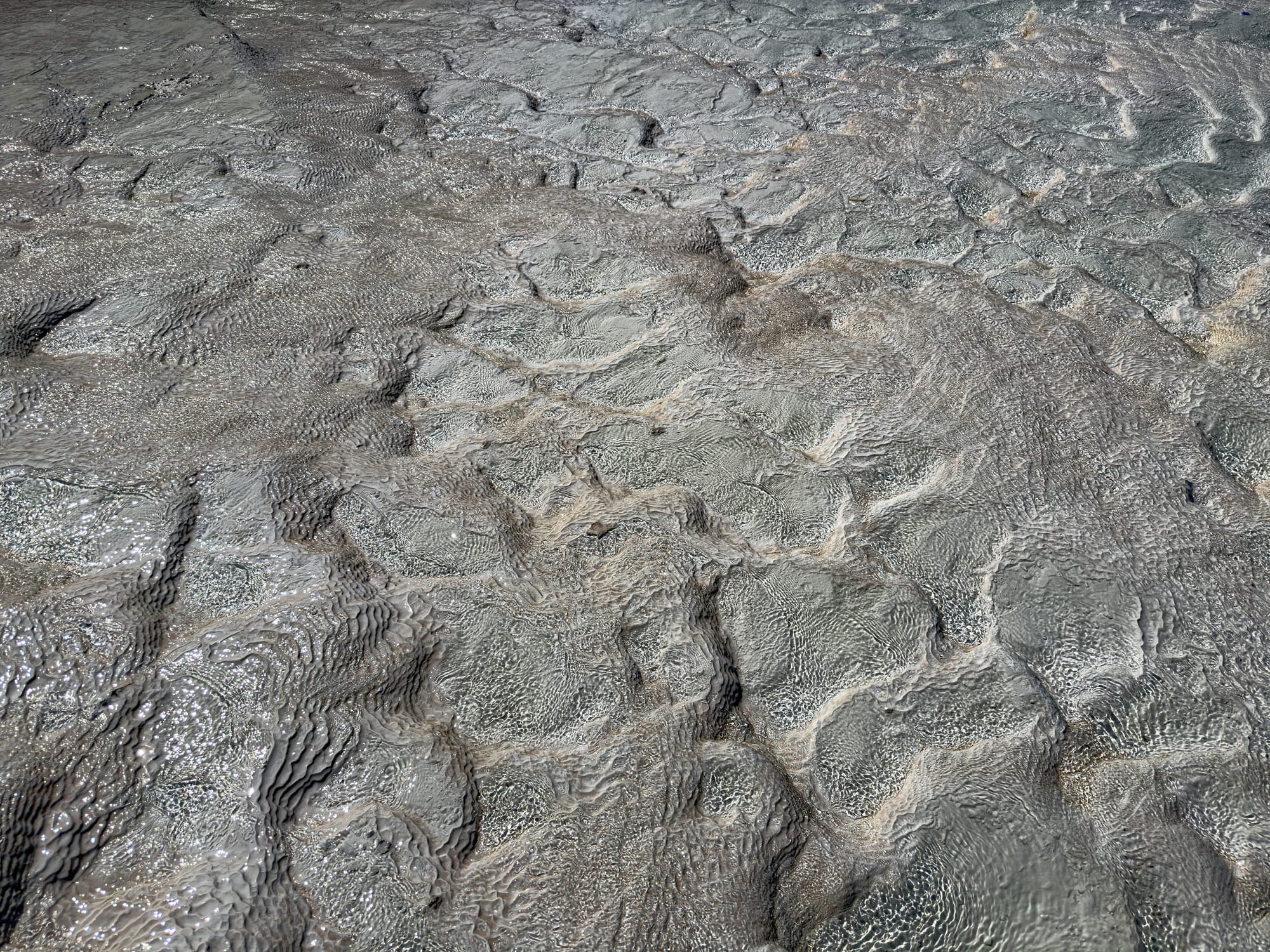
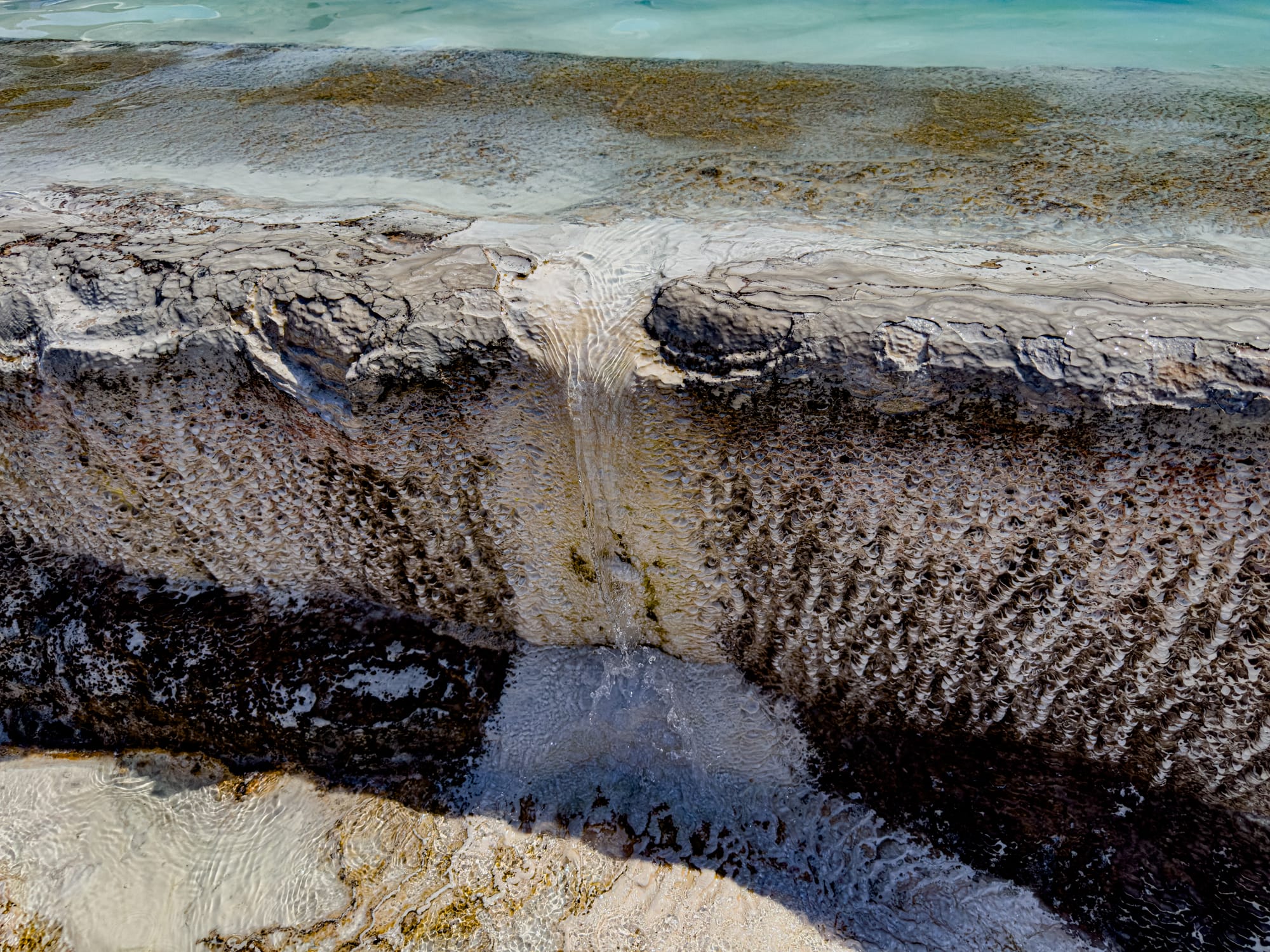
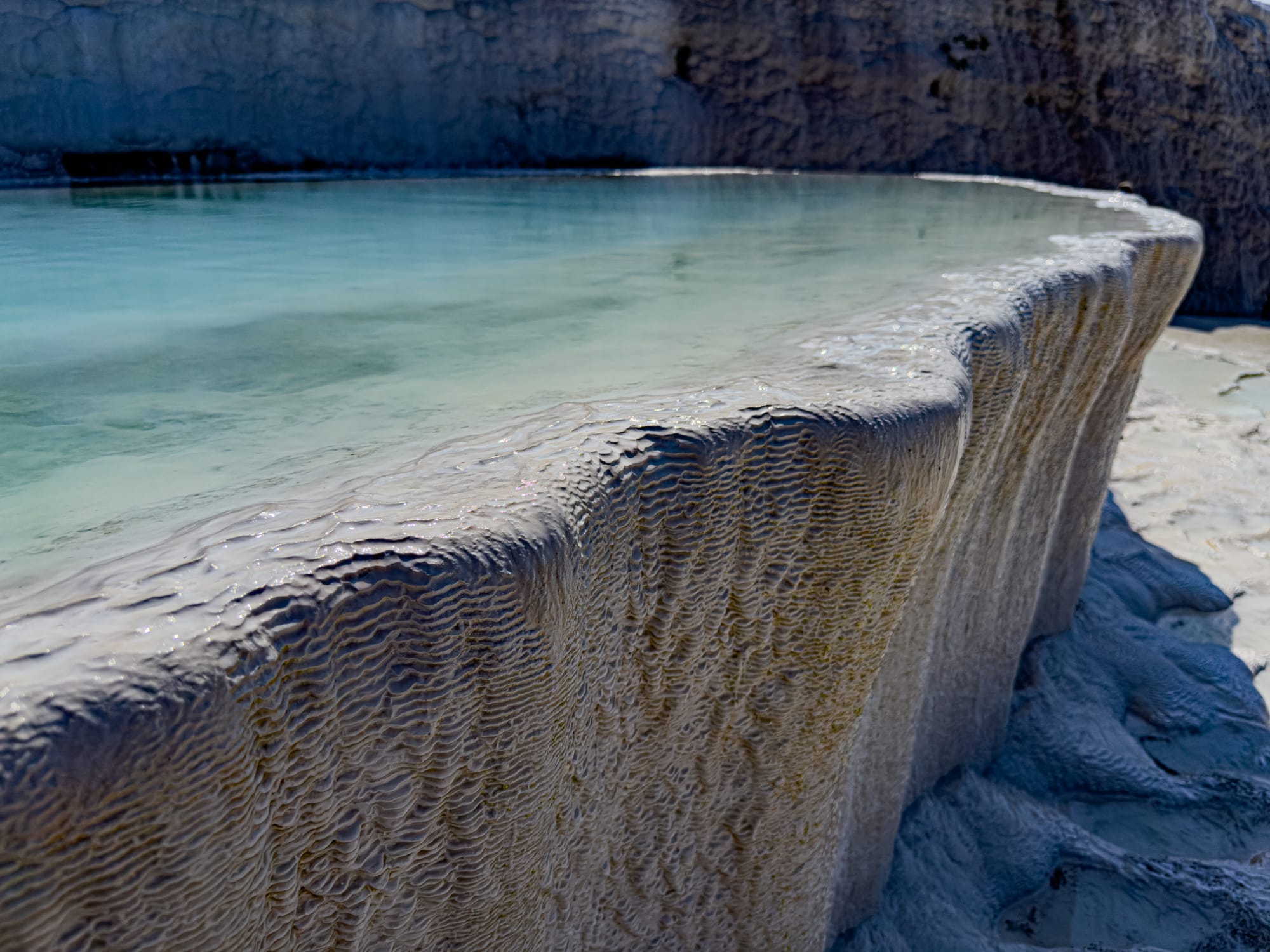
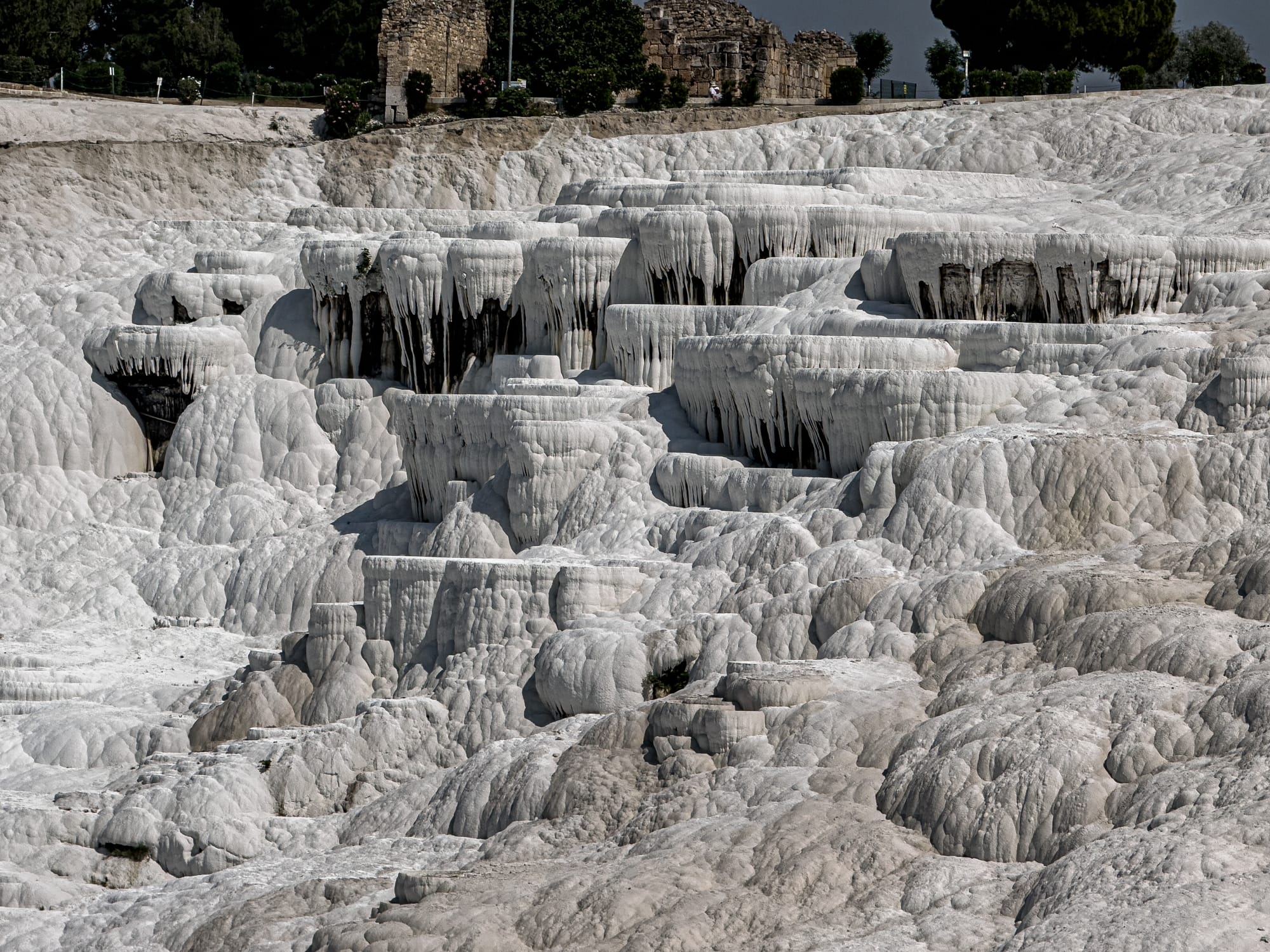
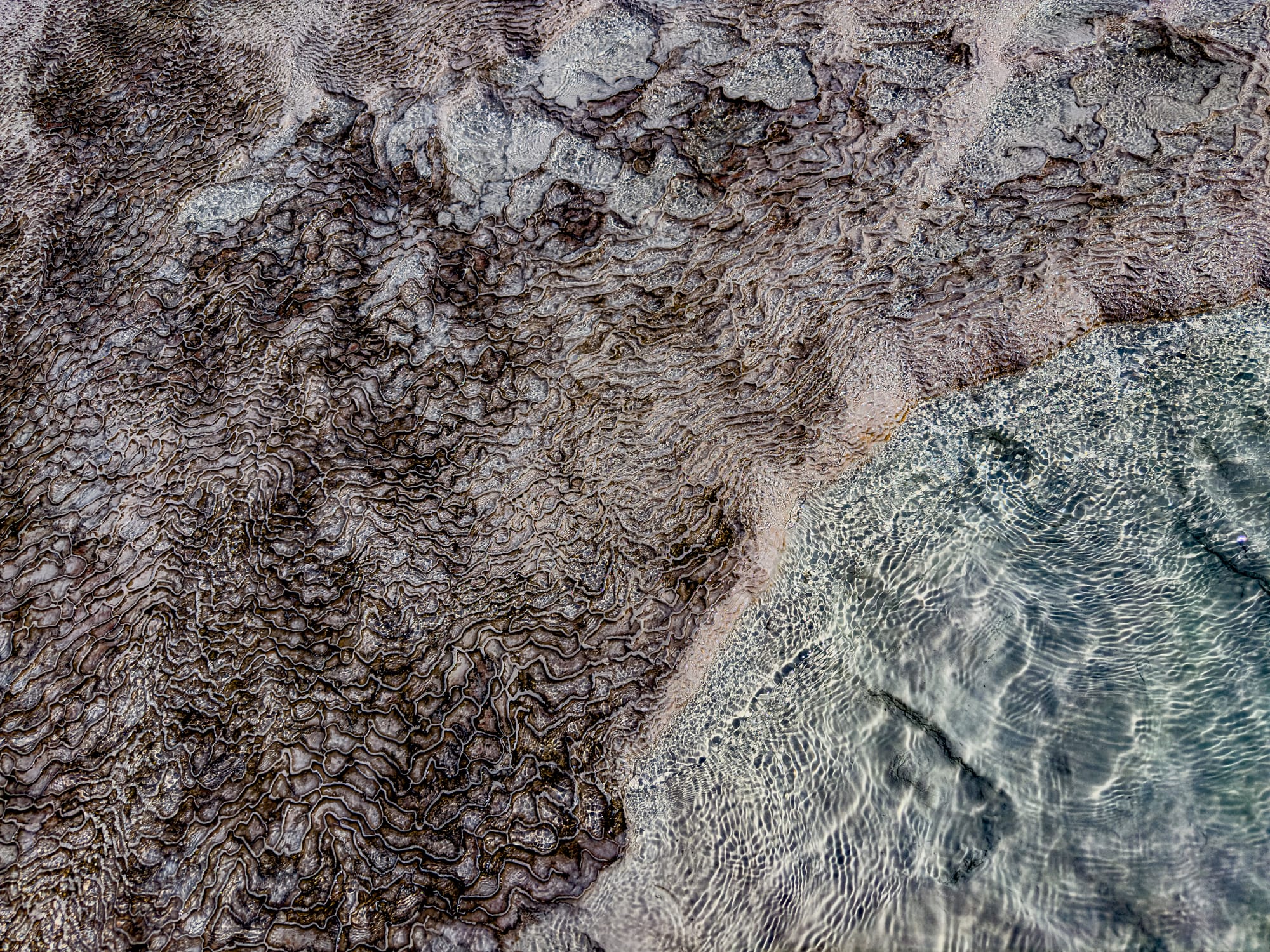
Mineral-rich water carves ripples, ridges, and overhangs into Pamukkale’s dazzling white travertine terraces
Photographically, the textures are a dream. Even close to sunset, as the light softened, the terraces continued to glow, and their patterns became even more pronounced. If you’re a photographer or visual artist, this place will absolutely hold your gaze.
The science behind the travertines
Pamukkale’s travertines are the result of a fascinating geochemical process. The water that feeds them originates from hot springs deep underground. As this water rises, it becomes saturated with calcium carbonate. When it reaches the surface and cools, the carbon dioxide it contains is released into the air, causing the calcium carbonate to precipitate out and form solid deposits.
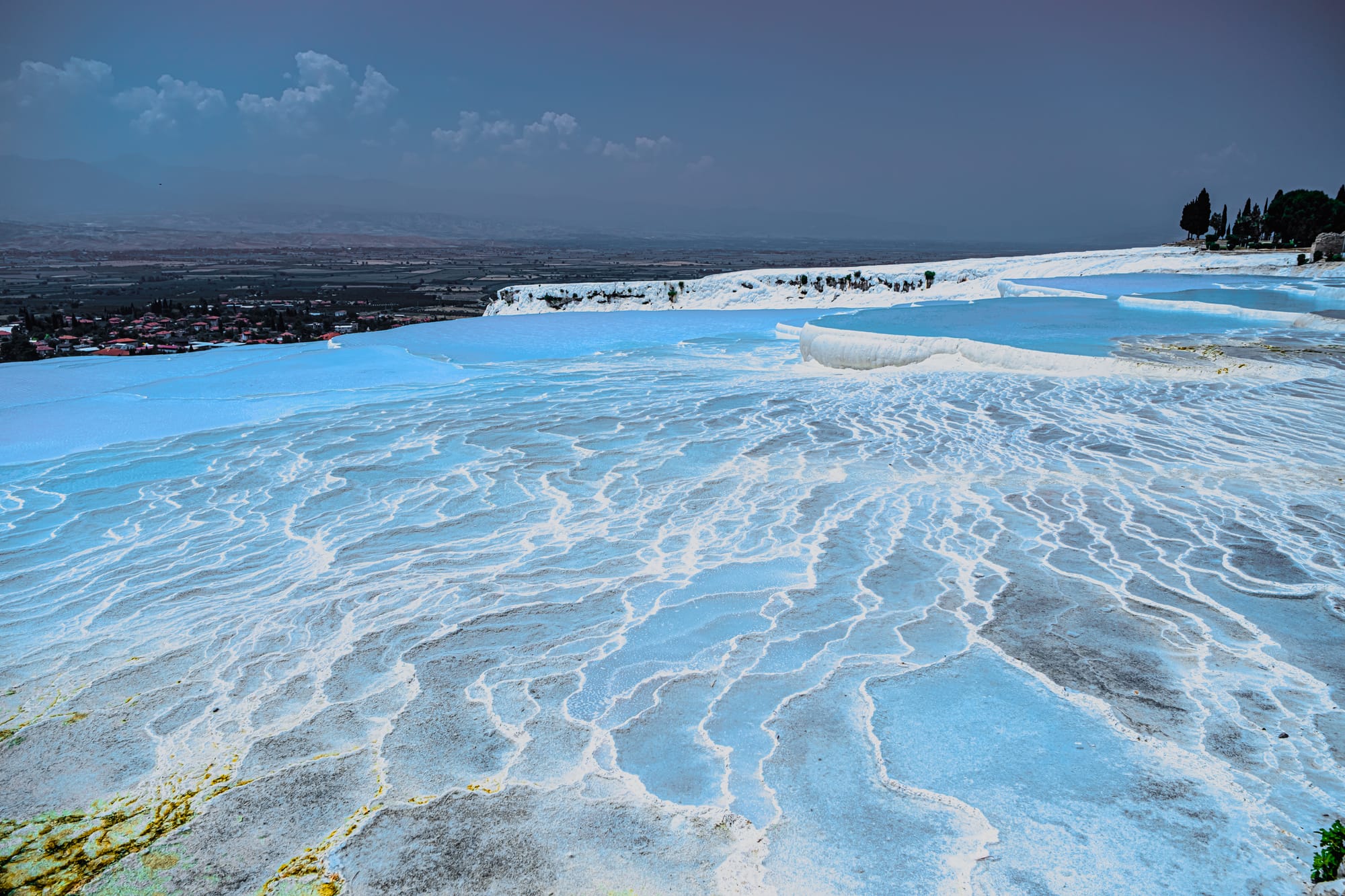
These deposits begin as a soft gel-like layer, which eventually hardens into the brilliant white stone. The flowing water continuously shapes and reshapes the terraces, keeping the site in a state of slow but constant change.
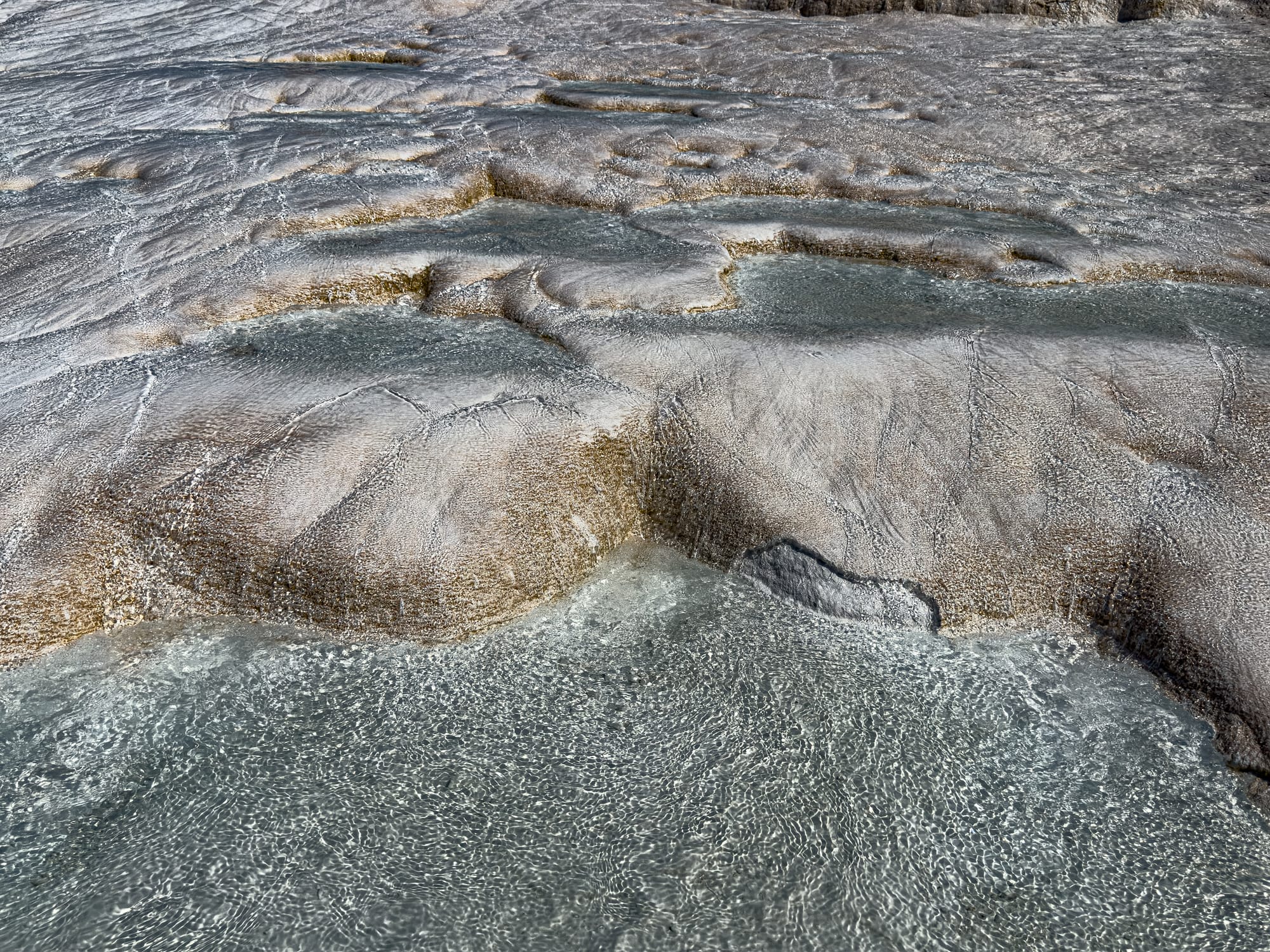
The pools fill and empty with the help of a water distribution system designed to protect the most fragile areas from erosion. You’ll notice that some parts of the travertines are dry—this is intentional, part of a rotation system that allows different areas to rest and recover.
The Cleopatra Pools
Although we didn’t get to visit them ourselves due to temporary closure, the Cleopatra Pools are a famed part of the Pamukkale experience. Also known as the Antique Pool, this thermal spring is said to have been a favorite of Cleopatra herself.
Today, the pool is filled with submerged marble columns—believed to have fallen during an earthquake—and mineral-rich waters that hover around a balmy 36°C (96°F).
Swimming here is an otherworldly experience: soaking amid ancient ruins beneath the open sky. While it wasn’t part of our day, we’d absolutely recommend checking whether it’s open if you’re planning your visit.
The paradox of popularity
There’s no denying that Pamukkale is crowded. It’s one of Turkey’s most visited natural sites, and yes, you’ll be sharing the view with dozens (or hundreds) of other people at any given time. But even so, it’s worth it.
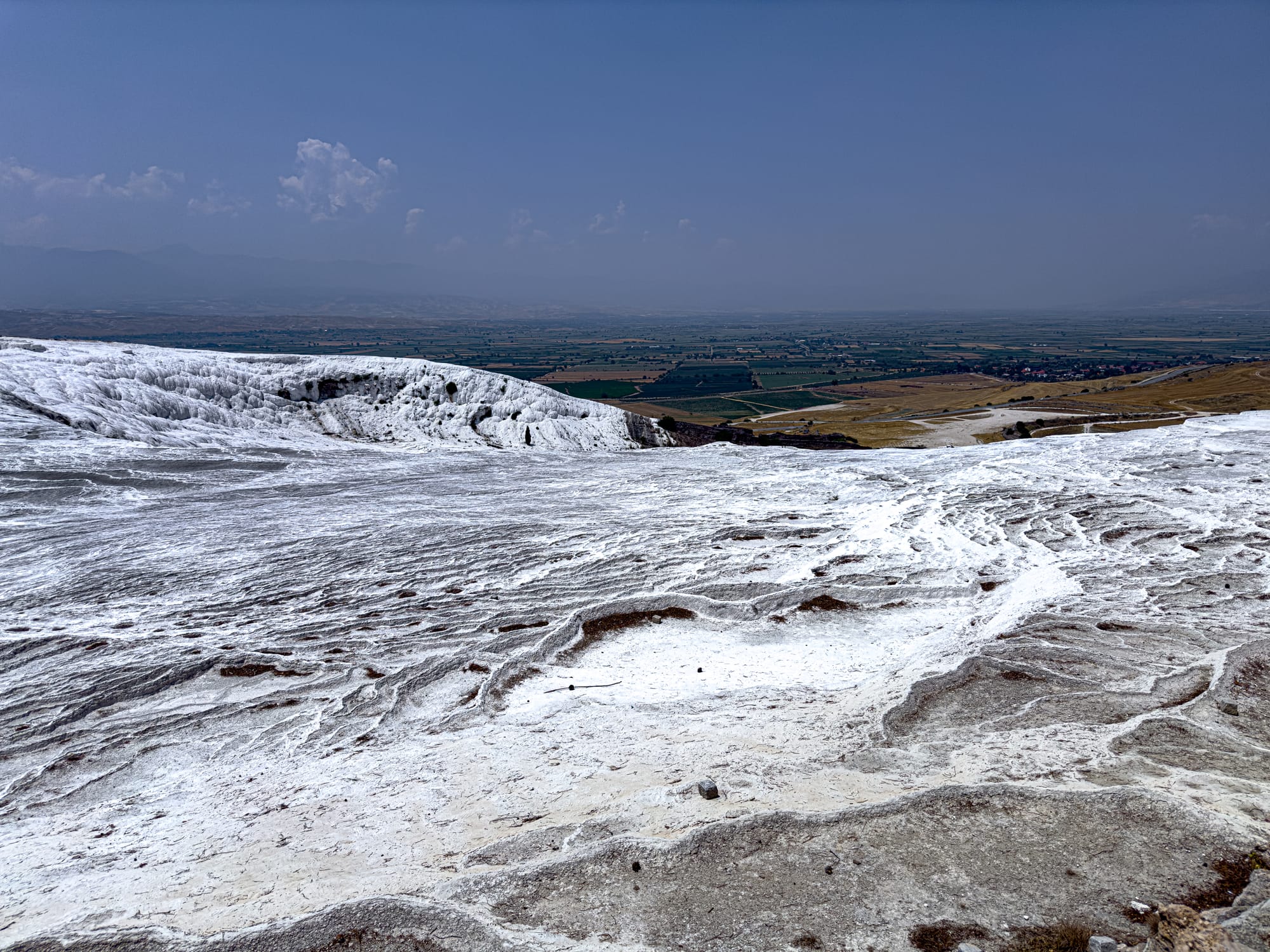
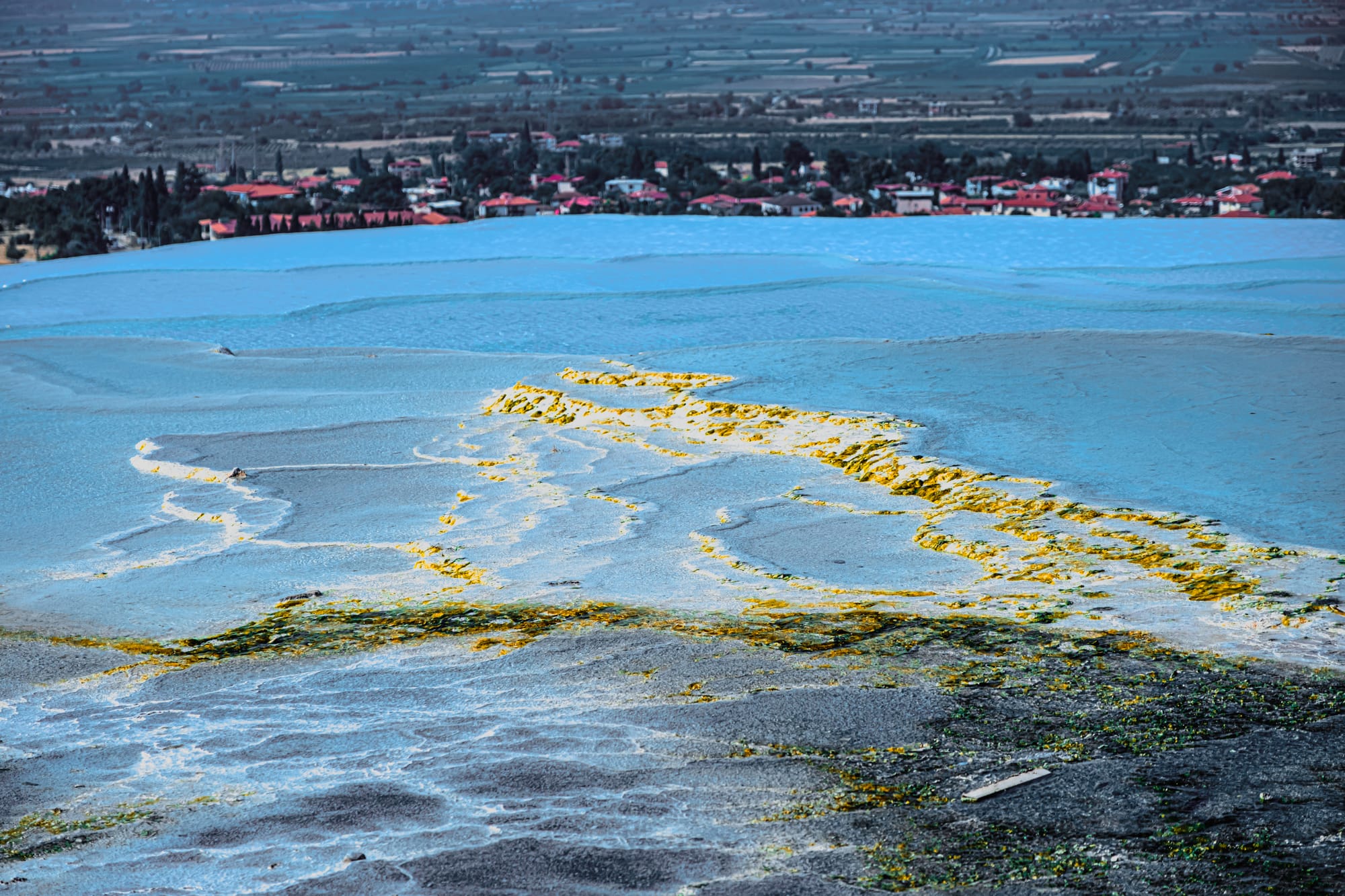
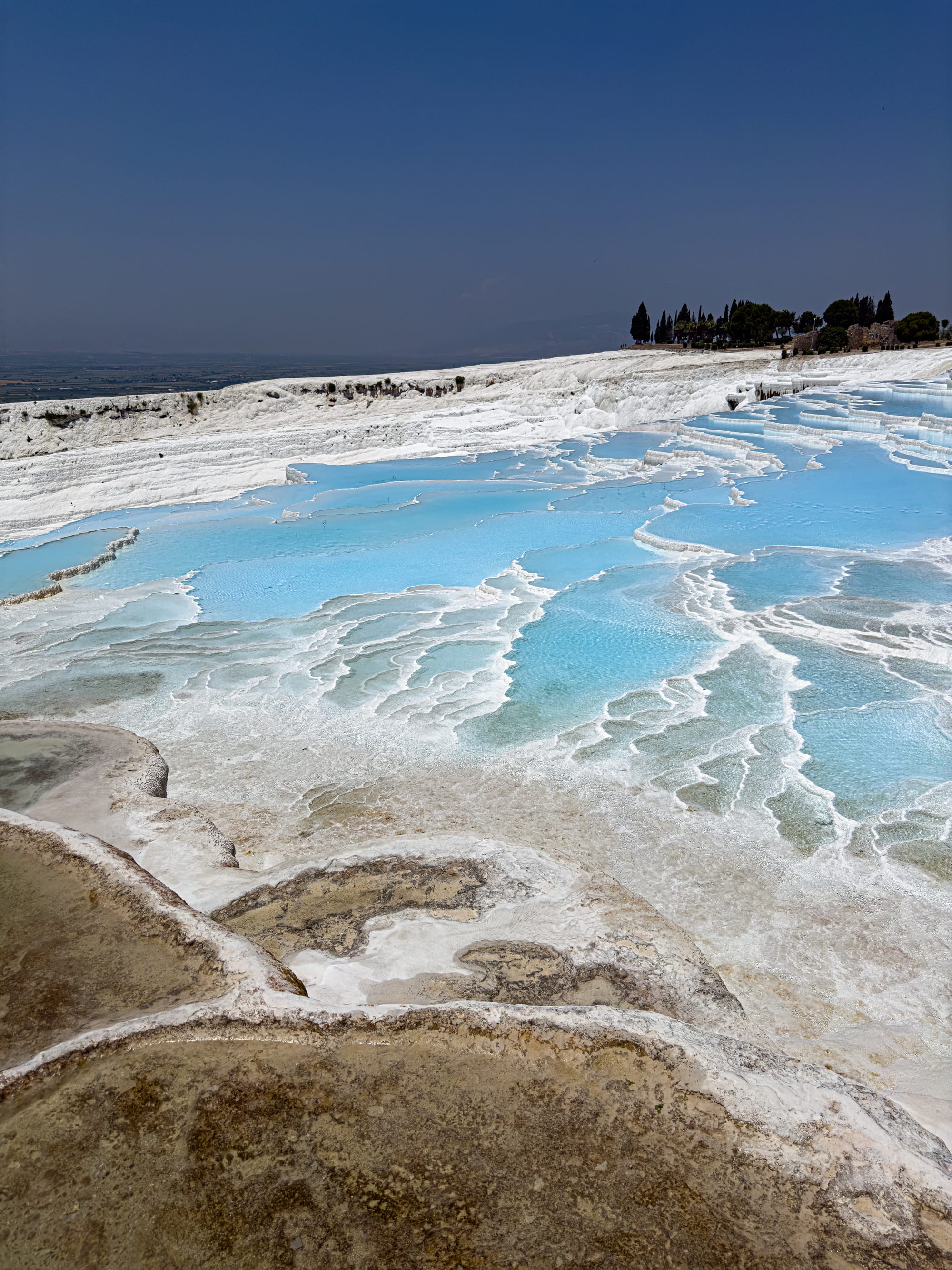
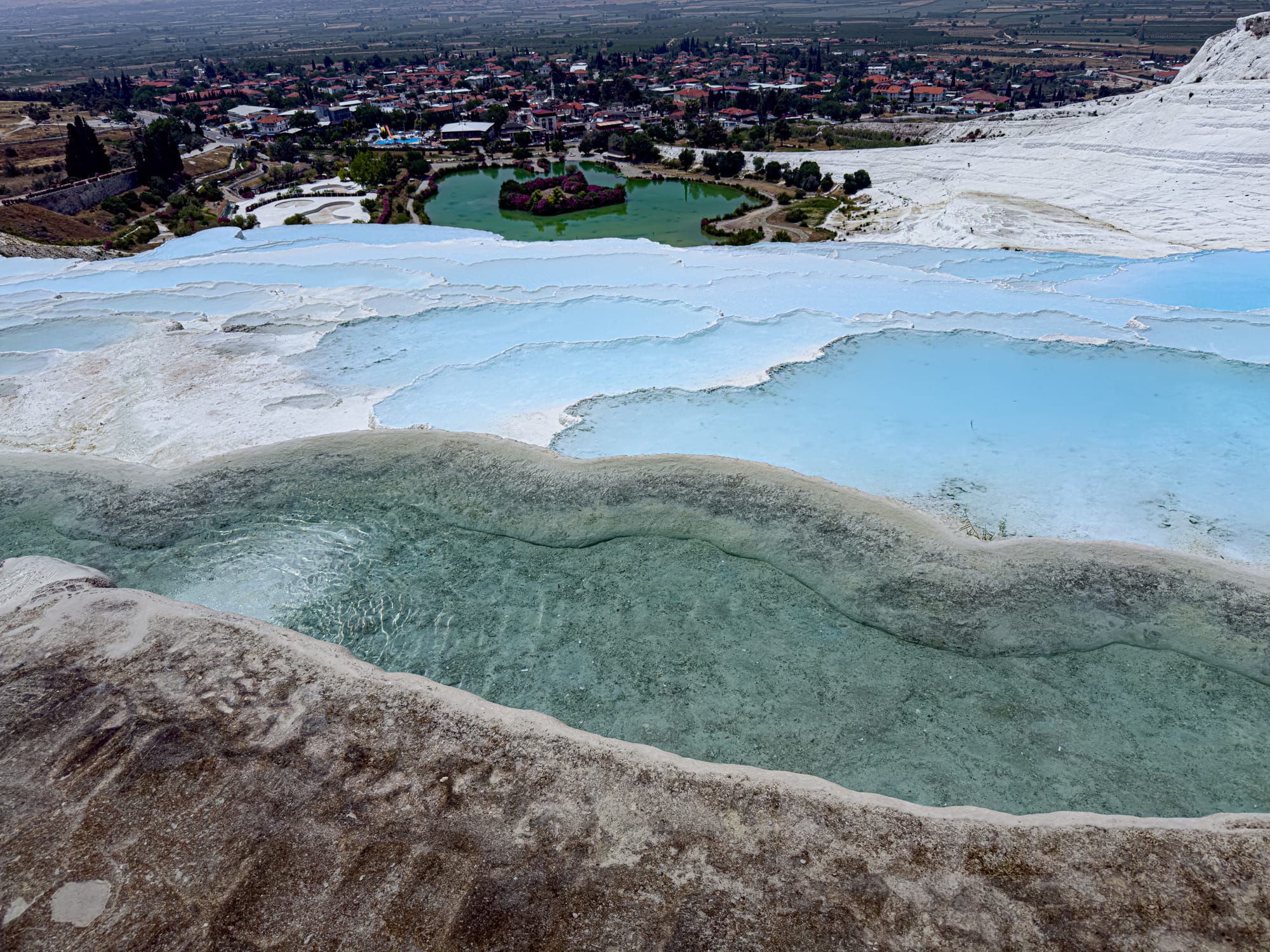
From gleaming white ridges to blue pools and bursts of sulfur yellow, Pamukkale defies the palette
There’s something undeniably elemental about the place—earth, water, time, and mineral converging into something both ancient and ephemeral. Whether you’re soaking your feet, taking photos, or just sitting quietly on a ledge, the site invites presence.
Getting there
We visited Pamukkale as part of this guided tour from Antalya that also included Hierapolis. The tour gave us a helpful overview of the site’s significance, as well as ample free time to explore at our own pace. If you’re staying in Antalya and want a seamless way to experience both the travertines and the ruins, this is a great option.






